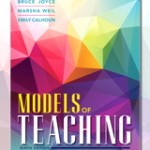 As an educational leader, it is likely that you have searched for research to support the development of professional learningexperiences for educators and to inform policy design work. Professional developers will immediately recognize the name Bruce Joyce. Publications by Drs. Bruce Joyce and Beverly Showers, particularly their findings on the effects of peer coaching, are considered to be seminal work in our field (e.g., Student Achievement through Staff Development (Joyce & Showers, 2002). Many preservice educators have designed teacher preparation courses around Models of Teaching. Dr. Joyce and fellow authors, Drs. Marsha Weil and Emily Calhoun recently released the Ninth Edition of Models of Teaching. It has been my good fortune to include both Bruce Joyce and Emily Calhoun among the colleagues that have shaped my career. Last week, I had the privilege of visiting Bruce and interviewing him about the Models of Teaching and his current thinking on professional learning.
As an educational leader, it is likely that you have searched for research to support the development of professional learningexperiences for educators and to inform policy design work. Professional developers will immediately recognize the name Bruce Joyce. Publications by Drs. Bruce Joyce and Beverly Showers, particularly their findings on the effects of peer coaching, are considered to be seminal work in our field (e.g., Student Achievement through Staff Development (Joyce & Showers, 2002). Many preservice educators have designed teacher preparation courses around Models of Teaching. Dr. Joyce and fellow authors, Drs. Marsha Weil and Emily Calhoun recently released the Ninth Edition of Models of Teaching. It has been my good fortune to include both Bruce Joyce and Emily Calhoun among the colleagues that have shaped my career. Last week, I had the privilege of visiting Bruce and interviewing him about the Models of Teaching and his current thinking on professional learning.
Bruce is internationally recognized for his research, writing, and consultation focused on professional development design and implementation, school renewal, models of teaching and programs for beginning and struggling readers. He has extensive experience as both a classroom teacher and in higher education. Dr. Joyce was a professor at the University of Delaware, the University of Chicago and Teachers College, Columbia University, where he directed the laboratory school and elementary teacher education Program. In recent years, he has supported the work of educational leaders across the US, in Canada, India, and the United Kingdom.
Browsing through heavily ladened book shelves in Dr. Joyce’s office, I noticed past editions of Models of Teaching published not just for English speaking readers, but also in Chinese, Spanish, German, etc.It is remarkable how influential this work has been over the years and how it continues to shape the teacher workforce with the release of this edition. I asked Bruce about how the ninth edition differs from prior editions. He commented that Models of Teaching: The Heart of the Core once again offers preservice faculty who prepare future teachers with multiple approaches to teaching that are grounded in research and experience, but what makes this edition so timely is the focus on the Common Core. Additionally, the revisions make the publication more useful for practicing teachers. Bruce shared that many of the revisions focused on providing practical strategies for teams of teachers to use in their professional development. The Models of Teaching (MOT) integrates theory and research with practical applications that are described using scenarios and video demonstrations.
As a long time student of his work, I recognize the importance of providing the theory along with demonstrations. MOT Edition Nine lends itself to collective work that extends the theory and demonstration by providing opportunities for practice and collaborative experiences that allow for coaching to occur. A professional development leadership team could study their data, review the models in MOT and select one that best fits their context to improve curriculum and instruction. For example, a team that is focusing on writing might decide to study the synectics model as a way to teach metaphoric thinking and writing and learn how to help students apply these skills in other content areas. The PLC could materials in the book and the web site to facilitate professional learning. PowerPoint slides, demonstration videos, peer coaching guides and links to a variety of resources are available at the free website.
Bruce stressed the importance of using the text along with the companion MOT website that provides free guides and resources designed to support professional learning experiences of future teachers, individual teachers in the workplace, and teams of teachers engaged in PLCs or other collaborative learning teams at the building level. The effort put into making this edition more interactive is not surprising. Throughout his career, Dr. Joyce has advocated for collaborative learning among educators, and co-author, Emily Calhoun has directly supported collective learning through intensive field work in schools across the country, in Canada, and abroad. The MOT website provides a discussion area where teachers and other users can join in dialogue. Bruce, Marci, and Emily will respond to questions and offer resources to support new or ongoing learning of best teaching practices.

In addition to the connections to the CCSS that Bruce highlighted, I believe that MOT has great potential for communities of teachers that are using the InTASC Model Core Teaching Standards to plan teacher development, particularly Standard 7: Planning for Instruction and Standard 8: Instructional Strategies. Another connection we talked about was the relevance to higher education faculty who are revising their programs based on new data from preservice assessment measures, such as edTPA.
You are welcome to contact Dr. Joyce with questions and to share your ideas on how this publication might be used in your context.
I would like to thank Bruce for his willingness to engage in this interview, and his life-long contributions to student and teacher learning.
Bruce Joyce, Booksend Laboratories Brucejoyce40@gmail.com
This blog by Deb Hansen, Senior Policy Analyst, West Wind Education Policy, is a revised version of a blog that was developed for the Council of Chief State School Officers’ (CCSSO) State Consortium on Educator Effectiveness (SCEE).
